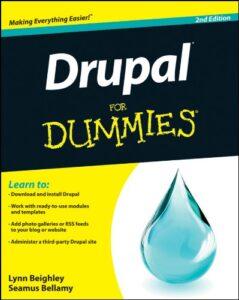Building a website can feel overwhelming. Choosing the right content management system (CMS) is critical. Drupal powers 1 in 8 websites, which speaks volumes about its capabilities. But why do so many people and businesses choose their websites run on Drupal? Let’s break it down step by step in this guide for website owners, so it’s easy to understand.
What Is Drupal?
Drupal is a free, open-source CMS. It’s used to create and manage websites of all kinds—small blogs, large e-commerce platforms, or even government portals.
It offers:
- Flexibility to customize.
- Powerful tools for managing content.
- Advanced security.

Why 1 in 8 Websites Run on Drupal?
There are several reasons Drupal stands out.
1. It Grows with Your Website
Drupal handles websites of all sizes. From personal blogs to corporate giants, it scales as your needs grow.
- Good for small and big projects.
- Can manage heavy traffic without breaking.
- Perfect for websites expecting to expand.
 Drupal For Dummies
Drupal For Dummies
Even if you have no Drupal experience, you’ll quickly learn how to download and install Drupal, set up your first content-managed site, apply templates, use modules, and more.
Drupal gurus Lynn Beighley and Seamus Bellamy show you how to take advantage of what Drupal has to offer, make the most of the new features in Drupal 7, and demystify perplexing Drupal issues.
- Drupal is a free, open source modular framework and content management system designed for content-managed web sites
- Shows you how to download Drupal; no programming experience required
- Explains how to organize and create your site’s content, apply templates, and get your first site up and running
- Details the ways to use modules and third-party templates
Whether you’re looking to implement a flexible content management system, turbocharge a blog with photo galleries, or administer a third-party Drupal site, this book gets you off to a running start!
2. Security You Can Trust
With online threats increasing, security is crucial. Drupal has a dedicated security team. They keep the platform updated and provide patches for vulnerabilities.
- Frequently updated.
- Meets government and enterprise-level security standards.
- Ideal for sensitive industries like healthcare or finance.
3. Supports Multiple Languages
If your audience is global, Drupal is a great pick. It supports 100+ languages out of the box.
- Easy to set up multilingual sites.
- Built-in translation tools.
- Helps connect with diverse audiences.
4. Freedom to Customize
Drupal’s modular system gives you control. You can add features through modules and change designs with themes.
- Thousands of free modules and themes.
- Great for unique website needs.
- Tailored user experiences.
5. Active Community
Drupal’s open-source nature means it’s supported by a massive community. Developers, designers, and users contribute improvements and offer help.
- Free support forums.
- Regular updates and innovations.
- Tutorials and guides available online.
Is Drupal Hard to Use?
Drupal has a learning curve, especially for beginners. But once you get the hang of it, it’s highly rewarding. For simple sites, you may need some help setting it up. For more complex projects, hiring a developer might be worth considering.
 Drupal 10 Development Cookbook – Third Edition: Practical recipes to harness the power of Drupal for building digital experiences and dynamic websites
Drupal 10 Development Cookbook – Third Edition: Practical recipes to harness the power of Drupal for building digital experiences and dynamic websites
This new and improved third edition cookbook is packed with the latest Drupal 10 features such as a new, flexible default frontend theme – Olivero, and improved administrative experience with a new theme – Claro. This comprehensive recipe book provides updated content on the WYSIWYG (What You See Is What You Get) editing experience, improved core code performance, and code cleanup.
Drupal 10 Development Cookbook begins by helping you create and manage a Drupal site. Next, you’ll get acquainted with configuring the content structure and editing content. You’ll also get to grips with all new updates of this edition, such as creating custom pages, accessing and working with entities, running and writing tests with Drupal, migrating external data into Drupal, and turning Drupal into an API platform. As you advance, you’ll learn how to customize Drupal’s features with out-of-the-box modules, contribute extensions, and write custom code to extend Drupal.
By the end of this book, you’ll be able to create and manage Drupal sites, customize them to your requirements, and build custom code to deliver your projects.
Case Study: The Michael J. Fox Foundation’s Transition to Drupal
The Michael J. Fox Foundation (MJFF), dedicated to Parkinson’s disease research, sought a robust digital platform to support their mission. They chose Drupal for its open-source nature and the strength of its large, vibrant community. This community aspect provided MJFF with a solid foundation for their digital initiatives, ensuring ongoing support and continuous innovation.
Key Outcomes:
- Enhanced Digital Presence: Drupal’s flexibility allowed MJFF to create a dynamic and user-friendly website, effectively engaging their audience.
- Scalability: As MJFF’s initiatives expanded, Drupal scaled seamlessly to accommodate growing content and user interactions.
- Community Support: The active Drupal community offered MJFF continuous support, facilitating ongoing improvements and adaptations to their digital strategies.
Future Trends with Drupal
- Headless CMS: Drupal can separate the backend from the frontend. This is helpful for apps or interactive web experiences.
- AI Integration: Tools for automation and personalization are becoming common.
- Accessibility: Drupal focuses on making websites accessible to everyone, including people with disabilities.
- Cloud Hosting: More users are opting for cloud-based Drupal hosting for better performance.
FAQs
Is Drupal better than WordPress?
Drupal is better for complex, secure, and scalable websites. WordPress is easier for beginners but may not match Drupal’s flexibility for large projects.
What type of websites use Drupal?
Examples include:
- Government portals (e.g., White House in the past).
- Large universities (e.g., Harvard, Stanford).
- Media companies (e.g., The Economist).
How much does Drupal cost?
The platform itself is free. Costs come from hosting, premium modules/themes, or hiring developers.
Is Drupal still relevant in 2025?
Yes, especially for businesses needing security, scalability, and advanced features. Its community is active, and its technology keeps evolving.
Quick Pros and Cons of Drupal
Pros
- Free and open-source.
- High security.
- Flexible and customizable.
- Handles large, complex websites.
- Supports multilingual and global projects.
Cons
- Steep learning curve.
- Requires regular updates.
- Not as beginner-friendly as some alternatives.
How to Start with Drupal
Getting started with Drupal is straightforward if you follow these steps:
- Download It: Go to Drupal.org and grab the latest version.
- Pick Hosting: Choose a hosting provider that supports Drupal, like HOSTINGER.
- Install Modules: Add functionality with free modules.
- Choose a Theme: Pick a theme for your site’s design.
- Learn: Explore tutorials and documentation from the Drupal community.
Final Thoughts
Drupal is a robust and reliable CMS. It’s not for everyone, but if you need a secure, scalable, and customizable platform, it’s worth exploring. For businesses expecting to grow or handle large traffic, Drupal is a great investment.
Still unsure? Start small, test the waters, and see if Drupal fits your needs. Remember, the flexibility it offers is why 1 in 8 websites run on Drupal—and yours could too.
Now loading...





